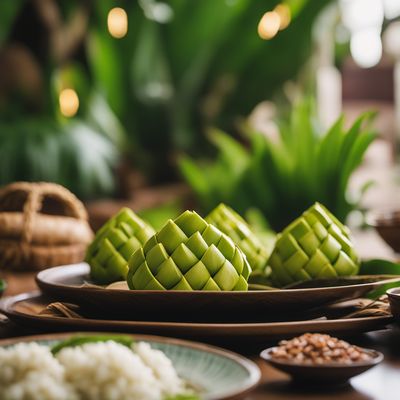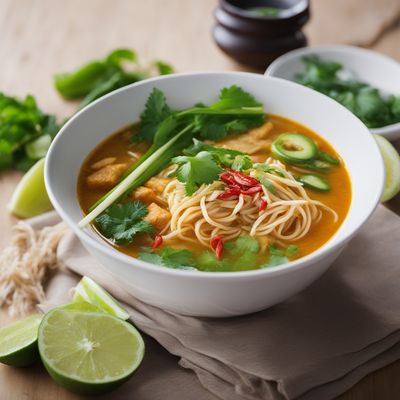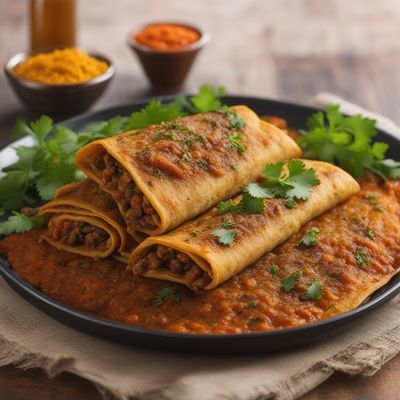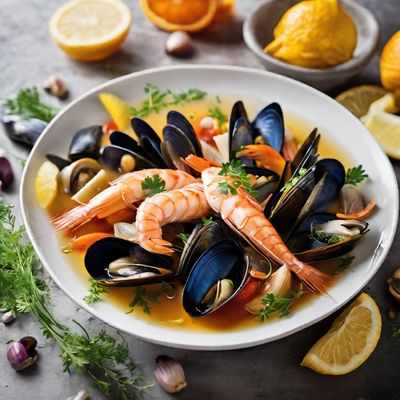
Recipe
Molecular Gastronomy Laksa
The Molecular Twist: Deconstructed Laksa
4.8 out of 5
In the realm of molecular gastronomy, we reimagine the beloved Malaysian dish, Laksa. This avant-garde adaptation combines the traditional flavors of Laksa with innovative techniques, resulting in a visually stunning and gastronomically delightful experience. Prepare to embark on a culinary journey like no other, where science meets art on your plate.
Metadata
Preparation time
30 minutes
Cooking time
20 minutes
Total time
50 minutes
Yields
4 servings
Preparation difficulty
Medium
Suitable for
Pescatarian, Dairy-free, Gluten-free, Nut-free, Low-carb
Allergens
Shellfish (prawns), Eggs, Soy (tofu)
Not suitable for
Vegan, Vegetarian, Paleo, Keto, High-protein
Ingredients
While the original Laksa is a hearty noodle soup, this molecular gastronomy version deconstructs the dish, transforming it into a visually captivating and multi-textured creation. The flavors remain true to the traditional recipe, but the presentation and techniques used are entirely unique, showcasing the possibilities of molecular gastronomy. We alse have the original recipe for Laksa, so you can check it out.
-
200g (7 oz) rice noodles 200g (7 oz) rice noodles
-
200g (7 oz) prawns, peeled and deveined 200g (7 oz) prawns, peeled and deveined
-
200g (7 oz) chicken breast, thinly sliced 200g (7 oz) chicken breast, thinly sliced
-
200g (7 oz) tofu, cubed 200g (7 oz) tofu, cubed
-
4 eggs 4 eggs
-
1 liter (4 cups) chicken stock 1 liter (4 cups) chicken stock
-
200ml (7 fl oz) coconut milk 200ml (7 fl oz) coconut milk
-
2 tablespoons laksa paste 2 tablespoons laksa paste
-
1 tablespoon fish sauce 1 tablespoon fish sauce
-
1 tablespoon tamarind paste 1 tablespoon tamarind paste
-
1 tablespoon palm sugar 1 tablespoon palm sugar
-
1 tablespoon vegetable oil 1 tablespoon vegetable oil
-
Fresh cilantro, bean sprouts, and lime wedges for garnish Fresh cilantro, bean sprouts, and lime wedges for garnish
Nutrition
- Calories (kcal / KJ): 450 kcal / 1884 KJ
- Fat (total, saturated): 20g, 10g
- Carbohydrates (total, sugars): 40g, 5g
- Protein: 30g
- Fiber: 5g
- Salt: 2g
Preparation
-
1.Cook the rice noodles according to package instructions. Drain and set aside.
-
2.In a large pot, heat the vegetable oil over medium heat. Add the laksa paste and cook for 2 minutes until fragrant.
-
3.Add the chicken stock, coconut milk, fish sauce, tamarind paste, and palm sugar to the pot. Bring to a simmer and let it cook for 10 minutes.
-
4.Meanwhile, prepare the eggs by separating the yolks from the whites. Set aside.
-
5.In a separate pan, cook the prawns, chicken, and tofu until cooked through. Set aside.
-
6.Using a molecular gastronomy technique, create gel-like spheres from the laksa broth by using sodium alginate and calcium chloride. Drop small portions of the broth into a calcium chloride bath and let them set for a few minutes.
-
7.Assemble the dish by placing the cooked rice noodles, prawns, chicken, and tofu in a bowl. Add the laksa broth spheres and garnish with fresh cilantro, bean sprouts, and lime wedges.
-
8.Just before serving, carefully place the egg yolks on top of the dish, allowing them to add a creamy richness when broken.
Treat your ingredients with care...
- Rice noodles — Cook according to package instructions, ensuring they are al dente for the best texture in the dish.
- Laksa paste — Adjust the amount according to your desired level of spiciness.
- Tamarind paste — If unavailable, substitute with lime juice for a tangy flavor.
- Sodium alginate and calcium chloride — Follow the instructions provided with the molecular gastronomy kit for creating the laksa broth spheres.
- Egg yolks — Handle with care when placing them on top of the dish to avoid breaking them prematurely.
Tips & Tricks
- Experiment with different molecular gastronomy techniques to create unique textures and presentations.
- Enhance the laksa flavor by adding a touch of lemongrass or kaffir lime leaves to the broth.
- For a vegetarian version, omit the prawns and chicken, and replace them with mushrooms and additional tofu.
- Serve the laksa in individual glass bowls to showcase the vibrant colors and layers of the dish.
- Pair this molecular gastronomy laksa with a crisp and refreshing white wine to complement the complex flavors.
Serving advice
Serve the deconstructed laksa as a main course, allowing each guest to mix the components together before enjoying. Encourage them to break the egg yolks and let the creamy richness blend with the other elements of the dish.
Presentation advice
Present the dish in a visually appealing manner by arranging the rice noodles, prawns, chicken, tofu, and laksa broth spheres in an artful composition. Garnish with fresh cilantro, bean sprouts, and lime wedges for a pop of color.
More recipes...
More Malaysian cuisine dishes » Browse all

Nasi kandar
Nasi kandar is a popular Malaysian dish that is made with rice and a variety of curries and side dishes. It is a flavorful and spicy dish that is...

Ketupat
Ketupat is a traditional Indonesian rice cake that is often served during special occasions such as weddings or religious holidays. It is a simple...

Kari ayam
Chicken Curry
Kari ayam is a traditional Malaysian curry dish made with chicken and a blend of spices.










